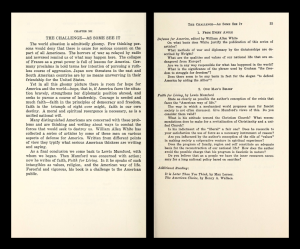Primary Source Set
World War II, Part 1: North Carolina Before Pearl Harbor
Though World War II began in September of 1939, it was not until late 1941 that North Carolina and the United States officially entered into the war. This part of the World War II lesson uses photographs, newspaper articles, and journal entries to illustrate how North Carolinians perceived the Second World War before American involvement and to describe the actions taken in North Carolina in preparation for the war.
Time Period
1940-1941
Grade Level
Undergraduate
Transcript
The University of North Carolina Library Extension Publication. The United States in the World Crisis
Library extension publications from the University of North Carolina allowed individuals outside of the University to receive study outlines about different subjects. In this study outline about the United States’ relationship to the ongoing Second World War, a chapter called “The Challenge–As Some See It” discusses potential American involvement in the war and provides recommended readings and discussion questions for people interested in the topic.
Contributed to DigitalNC by University of North Carolina at Chapel Hill
The University of North Carolina at Chapel Hill (Orange County)
Background
World War II had raged on for two years when Japanese forces unexpectedly attacked the American naval base at Pearl Harbor on December 7, 1941. While the United States had remained a neutral force during the early years of the war, it was the attack on Pearl Harbor that drew the nation, and North Carolina, into the conflict.
Before the attack on Pearl Harbor, the United States prepared itself for potential hostilities. On September 16, 1940, President Franklin D. Roosevelt signed into law the Selective Training and Service Act. This law, better known as the “draft,” required American men between the ages of 21 and 35 to register for military service. Around 362,500 people from North Carolina served in the war, most of whom were drafted. 69,000 of that number were Black North Carolinians, along with 7,000 North Carolinian women. The United States also prepared for war by building and expanding military bases, particularly in North Carolina. Already-established installations like Fort Bragg experienced rapid growth in both construction and population. Sites like Fort Bragg made North Carolina the top state in training the most military personnel during World War II.
While American soldiers trained in military bases and began to join in the fighting overseas, regular citizens had to adjust to a new life at home. War led to substantial changes in the economy and in everyday life for North Carolinians. The scarcity of certain goods, like sugar, caused the government to force citizens to ration. Factories and textile mills across North Carolina also experienced change as they shifted to producing materials for the war. Many of the workers in these factories were women, who increasingly joined the workforce to fill the positions left behind by men who were drafted or had enlisted in the armed forces. Though rationing and increased production aided the war effort, the United States continued to seek out support for their military by promoting and selling war bonds to citizens.
Four years after the attack on Pearl Harbor, the war came to an end. United States forces used two atomic bombs to attack the Japanese cities of Hiroshima and Nagasaki in August of 1945. Japan officially surrendered soon after, marking the end of the war on September 2, 1945. Although the conflict was over, World War II made a lasting impact on North Carolina. The primary sources in this collection demonstrate the social and economic effects of the Second World War on the state and exhibit some of the contributions that North Carolinians made to the war effort.
Discussion Questions
Although the United States did not enter World War II until late 1941, the country still made preparations for potential hostilities. In what ways did North Carolina and its citizens prepare for the war?
Take a look at the chapter from the Library Extension Publication about the United States in relation to World War II. What are the recommended readings about? Why do you think the creators of this study guide picked these readings for this topic?
Military bases in North Carolina experienced a great deal of growth and expansion before the United States entered World War II. Workers were drawn to the construction at Fort Bragg, even if they were located far away. Why were workers so willing to travel to places like Fort Bragg for work? What kind of impact did the expansion of Fort Bragg and other military bases have on North Carolina?
Consider The Daily Tar Heel article about the antiwar rally held by university students. Why were these students protesting American involvement in the war?
More than any other state, North Carolina had the highest number of rejected draftees during World War II. The Roanoke Rapids Herald article describes the opening of a resident center to rehabilitate the young men who were rejected from serving in the armed forces. What social or economic factors may have contributed to the large rejection rate of draftees in North Carolina?
This primary source set was compiled by Isabella Walker.
Updated January 2025
